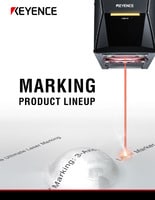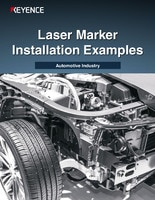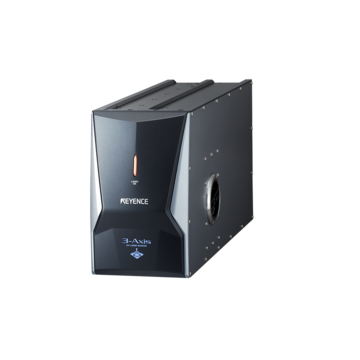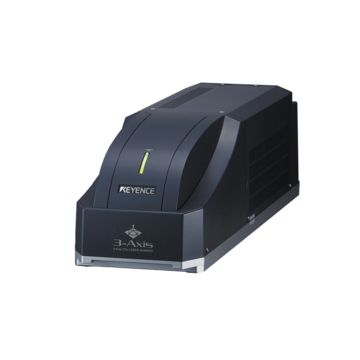Laser Marking Systems / Laser Markers
What is an Industrial Laser?
-
Tags:
- Laser Marking , Laser Engraving , Laser Cutting
When you think of the word laser, many things may come to mind. A former teacher who used a laser to point at the board, a cat chasing a laser, laser hair removal, or perhaps even laser surgery. All these applications are examples of commercial lasers, but many people do not consider another category of lasers that lead manufacturing processes behind the scenes—industrial lasers.
Industrial lasers are cutting, marking, and welding on the production line in automotive, semiconductor, electronic devices, food and pharmaceutical, medical, metals, and film/sheet industries. An industrial laser produces anything from small one-off product markings on consumer products to large production batches of precise, efficient, and permanent processing.
This industrial laser processing outperforms classic manufacturing methods like stamping, printing, sawing, and heat welding. In this blog, we’ll explore how industrial lasers dominate the manufacturing world because of the versatility of processing, materials, and types of lasers.
Types of Industrial Lasers
Fiber
Fiber lasers use an optical fiber resonator for amplifying the laser beam. The optical fiber creates a high speed and high output, generally around a 1090 nm wavelength.
Because of the high speed and high output, a fiber industrial laser is mostly used on metals for engraving, annealing, and cutting. Fiber lasers are frequently used in the automotive and aerospace industries but also have applications in medical, electronics, etc.
UV
UV laser beams are created by passing a 1064 nm laser beam through two crystals for a final 355 nm wavelength. The 355 nm wavelength has incredibly high absorption levels, so it conducts the photolytic degradation process on materials. This process breaks bonds down directly instead of altering the surface area. Breaking down bonds prevents heat transfer, so the UV laser marking process is called “cold marking.”
The high absorption makes a UV industrial laser ideal for heat-resistant materials, and the “cold marking” is optimal for heat-sensitive materials. UV lasers mark glass, rubber, ceramic, plastic, gold, silver, copper, and products of any material where surface damage needs to be held to a minimum or even negated.
CO2
CO2 lasers use a long 10600 nm wavelength generated from CO2 and plasma. Because of the long wavelength, these lasers have the highest heat transfer out of all industrial lasers.
The long wavelength is perfect for plastics, coatings, wood, etc., and is commonly used in high-speed bottling applications.
We’re here to provide you with more details.
Reach out today!

How Industrial Lasers Work
Industrial lasers are placed next to the production line and above the target. The product moves down the line, and the industrial laser machine marks, cuts, or welds while the production line is moved. They perform just as well off the line in manual operations where products are presented to the laser by operators, robots, etc.
Industrial Laser Marking
Laser marking is one of the main uses for industrial lasers and is used in a variety of ways.
Black Annealing
Black annealing is an industrial laser marking process that utilizes carbon migration to create a black mark. A laser beam shoots onto the surface area of a material with carbon properties. The heating activates the carbon properties, and the properties migrate to the surface as a black mark.
The black annealing mark is high contrast and adds no texture like engraving or etching. This process is typical in the aerospace and medical industries for this reason.
Industrial Laser Engraving
Industrial engraving is an industrial laser marking method that utilizes evaporation to produce an indented mark. The industrial laser machine shoots a laser onto the target, heats it to the evaporation point, and removes layer(s) of the material in order to create depth.
Industrial engraving is popular for traceability marks, identification marks, and decorative pieces like jewelry. Depending on the material and industrial laser machine, the engraving ranges in depth. It is extremely common in the automotive industry for caste engine components.
Industrial Laser Etching
Industrial etching is an industrial laser marking method that uses melting and malleability to remove a very thin layer of material and "rough up" the surface so that light is absorbed when viewing. This makes the mark appear as white to the eye.
Etching can be used interchangeably with engraving in some industries, but not all. For example, medical implants do not allow etched marks because of the additional texture or raised marks that could collect dust.
We’re here to provide you with more details.
Reach out today!

Industrial Laser Cutting
Industrial laser cutting is a widely used process because of the clean cuts that hardly leave behind burrs. It works by focusing a laser light onto a target, amplifying it, and directing the beam across a cut line. The beam melts, burns, and then evaporates the material.
At KEYENCE, we manufacture industrial laser marking machines that double as laser cutters instead of selling two machines separately.
Discover more about this product.
Click here to book your demo.

Advancements in Industrial Laser Technology
Industrial laser technology has skyrocketed with advancement since its creation in the 1960s. When lasers were first used, scientists didn’t even know what to do with them. Today, industrial laser technology continues to grow with new trends for industrial laser machines.
At KEYENCE, our industrial lasers include a 3-Axis design, an internal camera, and a barcode reader. Our industrial laser marking, cutting, and welding keep up with fast production lines and non-geometric products.
We’re here to provide you with more details.
Reach out today!

Want to Learn More About Industrial Lasers?
Industrial lasers add efficiency, precision, and permanency to cutting, welding, and marking. With how prominent industrial lasers are in the manufacturing industry, it is advantageous to consider them for many use cases.
If you’re not already familiar with lasers, we know they can be intimidating—but KEYENCE can help. We specialize in all things industrial laser marking and processing. Our team is always ready for questions and can demo an industrial laser machine for your organization.
Industrial lasers have the opportunity to put you ahead of your competitors still using old manufacturing methods, so what are you waiting for? Contact us today!
Discover more about this product.
Click here to book your demo.



![Laser Marker Installation Examples [Electronic Device Industry]](/img/asset/AS_117224_L.jpg)




